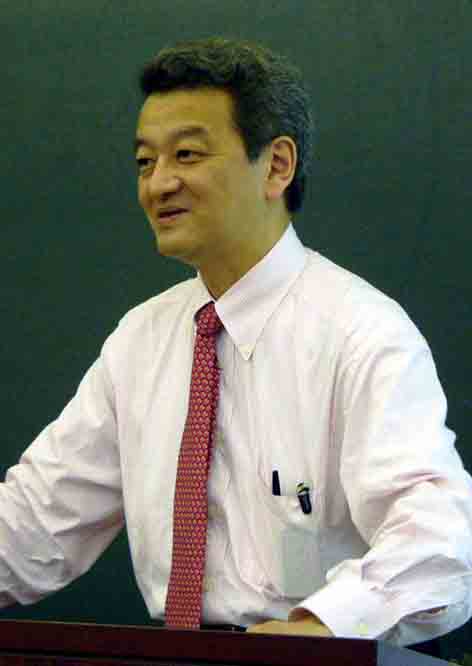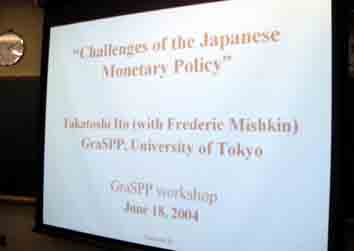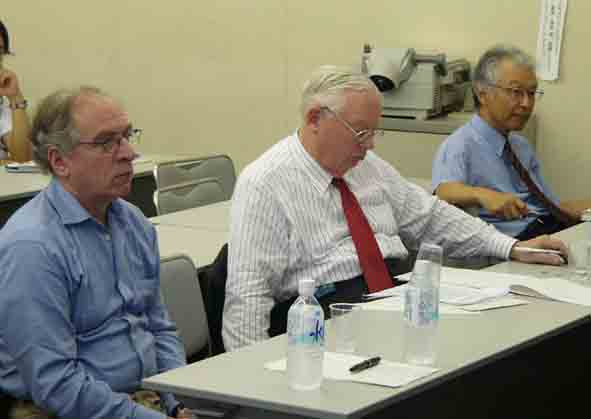gbvy[W > Events & Forums > φ€oΟτ[NVbv > 2004NxΔwϊ
φ€oΟτ[NVbv
2004N618ϊ ~jΫJt@X@uϊ{ΜτΫθΖπτv
u ϊ{ΜΰZτΜΫθ v@"Challenges of the Japanese Monetary Policy "
Ι‘²q@iεwφ€τεw@³φj
The Japanese economy has experienced serious deflation in the late of 1990s. Ito argued that the lesson learned from this experience was that deflation should be prevented from happening or should be stopped at the earliest stage. One of the problems arising from deflation is the higher real interest rate, where the real interest rate being defined by the nominal interest rate minus inflation rate. When the nominal interest rate becomes zero, the monetary policy loses the conventional weapon to stimulate the economy. This is known as the Liquidity trap, but Ito preferred to call it Deflationary trap.
One of the problems arising from deflation is the higher real interest rate, where the real interest rate being defined by the nominal interest rate minus inflation rate. When the nominal interest rate becomes zero, the monetary policy loses the conventional weapon to stimulate the economy. This is known as the Liquidity trap, but Ito preferred to call it Deflationary trap.
Another problem is that deflation increases the size of non-performing loans. The debt contract is fixed in nominal terms, so when the prices are dropping and the nominal income fall, borrowerfs real burden becomes larger. If more borrowers go bankrupt, then that will affect creditors, too. This is the debt deflation problem.
As the measure of deflation, there are two indicators, the GDP deflator and CPI. It is known that GDP deflator, which is calculates as a Paasche index, has a downward bias and CPI as a Laspeyres index has upward bias. The deviation between two indices is so large that it seems more than just a technical problem. Probably the current level of deflation is minus one percent because CPI is showing about zero and the GDP deflator about minus 2.5%.
Under the governor Hayami, BOJ adopted the zero interest rate policy in February 1999. The bank said that it would maintain the policy until the deflationary concern has been dispelled. But what was deflationary concern or when that was dispelled was not spelled out. In August 2000, the Bank abandoned the zero interest rate policy saying that economic recovery was under way  and deflationary concern was dispelled. But CPI was still showing deflation, and in fact, economic activity was about to slow down. Ito believes that the ending of zero interest rate policy was premature. Only after seven months, in March 2001, BOJ reinstated zero interest rate policy. But they did not say that they were going back to the policy, instead they said they were going to change the policy instrument for the monetary policy from interest rate to the current account balance at the BOJ, which is excess reserve at the central bank. This is so called quantitative easing.
and deflationary concern was dispelled. But CPI was still showing deflation, and in fact, economic activity was about to slow down. Ito believes that the ending of zero interest rate policy was premature. Only after seven months, in March 2001, BOJ reinstated zero interest rate policy. But they did not say that they were going back to the policy, instead they said they were going to change the policy instrument for the monetary policy from interest rate to the current account balance at the BOJ, which is excess reserve at the central bank. This is so called quantitative easing.
The amount of long-term government bond purchase per month was raised from 400 billion yen to 1.2 trillion yen in several steps. This probably had an effect of stimulating the economy. This is good.
The central bank must maintain credibility. But BOJ had made several mistakes. Ito believes that Governor Fukui is doing better job than former Governor Hayami, trying to restore credibility. Governor Fukui restated the commitment to zero interest rate policy so that people expect the current policy would continue for a long period. This is important because even if the central bank keeps the short term interest rate at zero, the long-term interest rate may rise on the expectation of the rate rise in the near future. Former Governor Hayami was known to favor to end the policy as soon as possible, and he actuary did. When the  zero interest rate policy was reintroduced in March 2001, which was still Hayamifs regime, he said that the policy would be maintained until the CPI inflation rate become stably about zero. But what the gstablyh means was not defined. Governor Fukui defined what gstablyh means more concretely in October 2003 as follows: inflation rate should be positive for several months, and policy members expect that inflation rate will remain positive in the future. Ito thinks that the elaboration on the necessary conditions for the exit from the zero interest rate policy was an improvement, but not a perfect condition.
zero interest rate policy was reintroduced in March 2001, which was still Hayamifs regime, he said that the policy would be maintained until the CPI inflation rate become stably about zero. But what the gstablyh means was not defined. Governor Fukui defined what gstablyh means more concretely in October 2003 as follows: inflation rate should be positive for several months, and policy members expect that inflation rate will remain positive in the future. Ito thinks that the elaboration on the necessary conditions for the exit from the zero interest rate policy was an improvement, but not a perfect condition.
Ito illustrated his advice for the improvement of the monetary strategy:The CPI inflation rate should become one, not zero, before the interest rate can be raised. CPI has upward bias, so zero inflation rate means that is actually still deflation. And Ito also recommended that the inflation rate can be targeted at 2.5 percent for 5 years, which is moderate, not high inflation.
Question.What do you think of the banking sector, are you optimistic?
Answer.We can be optimistic if we can maintain economic growth 4 percent next two years and inflation rate 1-2 percent positive for coming 2-3 years. Banks are actually earning huge profits, but they are spending money on writing off all the bad debts and so on.
